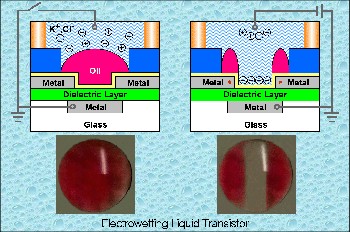
UC Engineering Research Widens Possibilities for Electronic Devices
Parting a tiny red sea at the University of Cincinnati: Todays and tomorrows sophisticated electronic devices may hinge on our ability to control microdrops of liquid on a surface. This effect, called electrowetting, controls the contact angle of a liquid on a hydrophobic surface through the use of an electric field.
As recently published in Applied Physics Letters and featured on the cover of the journal, Andrew Steckls research on liquid-state-field-effect transistors (LiquiFETs) promises improvements in such things as lab on a chip devices. These tiny devices, reminiscent of the Fantastic Voyage, can be introduced into the blood stream to monitor the bloods chemistry. Steckl, a professor in the Department of Electrical and Computer Engineering in the College of Engineering, calls it liquid logic using liquids to make electronic devices instead of solids.
One of the limitations of traditional health care instruments, for example, is that the information contained in the liquid (blood, in this example) must be translated into electrical signals that can be read in some kind of measuring device. Classical methods for this translation have used methods based on light and colorimetric measurement, direct optical sensing (using a video camera or detector) or combinations of optical excitation of fluorescent dyes.

Professor Andrew Steckl and doctoral student Duk Young Kim with the LiquiFET set-up.
Enter the liquid-state-field-effect transistors (LiquiFETs). Steckl and his doctoral student Duk Young Kim have designed and fabricated an electrowetting-based LiquiFET that operates in the liquid state and can directly convert charge-related information from the fluid into electronic, measurable signals. Such a device could co-exist in human body environment, for example, which is mostly liquid.
This technology could have applications in biology, health sciences and many other areas.
In microelectronics, we usually think small, says Steckl. But there are applications where you have to think large like big, big flat-panel televisions, with flexible panels perhaps. Other applications might be for objects that have a peculiar shape, like the curves and corners of an automobile.
Biomedical applications are also a natural, Steckl continues. Biomedical devices are both analytical where they take measurements and therapeutic where they deliver treatment. Analytical measurements need to be done in vitro (in glass, meaning in a test tube or other vessel) or in vivo (meaning in the body). Researchers are constantly striving for ways to optimize drug delivery to the patient. Devices perform many functions in drug delivery to measure the existing condition and to measure the effect of the medicine, for example. The doctor checks the condition after drug delivery, perhaps adjusts the dose, sees the effect and monitors the patients reaction.
More research is needed, but perhaps the same device could be used for both analytical and therapeutic purposes, says Steckl. With these devices, you have a real-time evaluation of effectiveness and a real-time adjustment of the dose. The faster that the doctor can know the effects of the drug, the better. More information on this research is available at the Web site for
.
UC is rapidly becoming a hot bed for research on electrowetting and more generally in microfluidics. For example, Steckl and his colleague Jason Heikenfeld have collaborated on electrowetting light valves and related applications. Many colleagues in UCs electrical engineering, mechanical engineering, chemistry and other disciplines are also heavily involved in microfluidics research.
The research on LiquiFETs was made possible through funding by a program at the National Science Foundation called SGER: Small Grants for Exploratory Research. Proposals for small-scale, exploratory, and high-risk research in the fields of science, engineering and education normally supported by NSF may be submitted to individual programs. Such research is characterized as preliminary work on untested and novel ideas; ventures into emerging research ideas; the application of new expertise or new approaches to established research topics; having extreme urgency with regard to availability of or access to data, facilities or specialized equipment, including quick-response research on natural disasters and similar unanticipated events; and efforts of similar character likely to catalyze rapid and innovative advances.
Yin and yang: Here you see Professor Steckls use of electronic devices in biological materials. Next, learn about Professor Steckls use of biological materials in electronic devices.
Related Stories
UC’s Ground Floor Makerspace births combat robots
April 17, 2024
In the heart of UC's 1819 Innovation Hub lies the Ground Floor Makerspace, an advanced and active hub of ingenuity where students, faculty and the community converge to bring their ideas to life. This includes being the birthplace of robots much like miniature race cars, combating fender to fender in an enclosed boxing ring. Combat robots like UC's Maximizer will again be fighting for first place in the National Havoc Robot League (NHRL) competition, slated for April 20.
UC researchers develop new CPAP device
April 17, 2024
Researchers at the University of Cincinnati are developing a VortexPAP machine that takes advantage of vortex airflow technology. A preliminary clinical study with current CPAP users demonstrated that the VortexPAP can deliver the pressure levels that are used in the subjects’ CPAP therapy, but the mask is more comfortable to wear. It has a minimalistic design that is less intrusive and barely touches the patient’s face.
UC architectural engineering alumna inspires high school students
April 16, 2024
University of Cincinnati alumna Emma Wilhelmus fell in love with engineering when she was in ninth grade. After taking drafting, architecture and engineering courses in high school, she set out to major in architectural engineering in college. Now, she is an engineering teacher at a local high school and hopes to inspire students.
